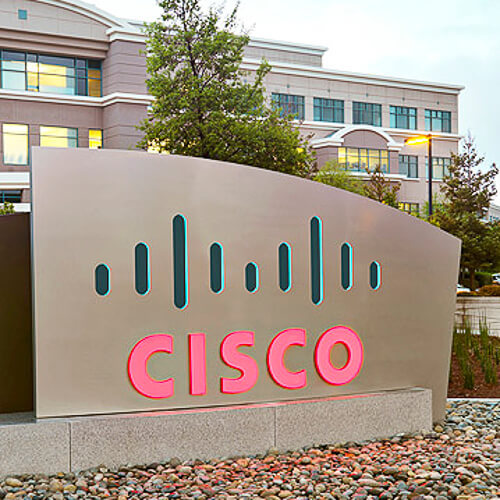Cisco rises on supply chain victories, but worries remain
Cisco expects its fiscal year 2023 revenues to grow between 4% and 6%, above most analyst expectations of 3% growth. However, the company continues to struggle in areas including increasing software sales.

Cisco executives suggested that the networking equipment vendor's supply chain troubles are finally easing, and that the company expects the issue to recede into the background in the months to come. That news, coupled with Cisco's relatively optimistic financial outlook, helped boost the company's share price following the release of its quarterly earnings.
But, more broadly, Cisco continues to face headwinds in its efforts to grab market share from rivals as well as in its attempts to shift its business from hardware to software.
Nonetheless, top Cisco executives are undoubtedly breathing a sign of relief in the aftermath of the release of the company's fiscal fourth quarter report Wednesday, considering the company's stock was up more than 6% in trading Thursday morning.
"In summary, we executed well on our strategy and transformation during what remains a very dynamic time. This led to a strong close to our fiscal year, setting several records across our business, thanks to the solid execution from our teams, our market-leading innovation and our continued growth of recurring revenue," CEO Chuck Robbins said during the company's quarterly conference call Wednesday, according to a Seeking Alpha transcription. "We also took decisive actions to help offset inflation and build resiliency in our supply chain, while investing in our business to position us well for long-term growth. The power of our technology continues to be a critical driver of economic growth and productivity."
Figure 1:  (Source: Cisco)
(Source: Cisco)
Supply chain and demand
Robbins suggested that the supply chain troubles that have bedeviled Cisco for more than a year may finally be smoothing out.
"While the component supply headwinds remain, they have begun to show early signs of easing," Robbins said. "The decisions we made and the multiple actions we have taken over the past two years are helping to improve our resiliency and will help offset cost inflation. These include adding new suppliers, leveraging alternative suppliers, redesigning hundreds of products to use alternative components with similar capability and targeted price increases, all of which position us for the future."
Analysts generally cheered the comments
"Cisco remains supply chain constrained, but backlog, price hikes and easing constraints enabled it to forecast ... fiscal year 2023 sales growth," wrote the financial analysts at Raymond James in a note to investors following the release of Cisco's latest earnings. The analysts noted that Cisco's revenue growth expectations for its fiscal year 2023, of between 4% and 6%, are above most analyst expectations of 3% growth.
But, Robbins said Cisco continues to see strong demand for its networking products from service providers, enterprises and others.
"Product orders increased more than 15% quarter over quarter, and were the second highest in company history, which was better than expected," wrote the financial analysts at Rosenblatt Securities in their own assessment of Cisco's report. "We think the strong sequential order performance demonstrates the sustained growth period the networking industry is experiencing, which appears sustainable in the face of macro concerns."
"The guide for the year and quarter are seen as a sign of confidence by the company," Elazar Advisors analyst Chaim Siegel told Reuters.
Countering headwinds
However, there remain a number of factors pushing against Cisco's progress. Chief among those is the apparent stagnation of the company's efforts to shift its business from selling boxes to selling bits and bytes.
The financial analysts at Raymond James noted that software has been stuck at 30% of Cisco's overall revenues for the past seven quarters. They noted that Cisco has a $2 billion backlog in software orders mainly because those sales are dependent on associated hardware, which remains restrained by supply chain constraints.
But that's not Cisco's only problem. For example, revenues in Cisco's biggest business segment – "Secure, Agile Networks" – clocked in at $6.09 billion in its most recent quarter, down 1% from a year earlier. Moreover, Cisco's core enterprise business continues to lose market share to fast-growing competitor Arista Networks, according to Futuriom.
Interestingly, Robbins suggested Cisco is working to better address its market opportunities with a new leadership strategy. "I think the teams have done a good job of really leading with what the customer needs and not building from the way the org chart is built," he said.
He pointed to the recent departure of Cisco's Todd Nightingale, EVP of enterprise networking and cloud. As part of that departure, Cisco is combining two of its infrastructure groups under EVP Jonathan Davidson. Enterprise Networking & Cloud (EN&C), previously led by Nightingale, and the Mass-Scale Infrastructure Group (MIG) will now both report to Davidson.
Related posts:
— Mike Dano, Editorial Director, 5G & Mobile Strategies, Light Reading | @mikeddano
About the Author(s)
You May Also Like




_International_Software_Products.jpeg?width=300&auto=webp&quality=80&disable=upscale)







